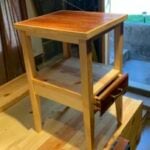Saw Tooth Sharpening
Welcome! / Forums / General Woodworking Discussions / Tools and Tool Maintenance/Restoration / Saw Tooth Sharpening
- This topic has 5 replies, 5 voices, and was last updated 6 years, 4 months ago by
Larry Geib.
-
AuthorPosts
-
 22 November 2017 at 5:19 pm #377776
22 November 2017 at 5:19 pm #377776I was watching a frame saw episode and got confused about heating saw teeth for sharpening. If I heat saw teeth of a tenon saw, let them cool, and then sharpen them, do I need to temper the blade by putting it in water or oil?
22 November 2017 at 10:51 pm #378161If you have a good saw do not heat it.just sharpen
If it has blue teeth it probably wont matter as the new saws are induction tempered.
I second what Dean said. First let me explain, when you heat treat steel you heat it to a temperature above 1K degrees depending on the alloy and then quench. Followed by heating to a much lower temp (Around 400 deg) for a prescribed amount of time to temper the steel, air cool to give it some strength and toughness. Hardness, Strength and toughness are three separate things. So if you have a saw that a standard file won’t cut, you probably have case hardened or induction hardened teeth. If you bought a “big box” Stanley saw, you probably have a induction hardened saw. I have one of those and they do last a long time but when it gets dull, toss it and go buy another one. That’s the idea with the cheaper made saws. The manufacturer doesn’t want you to resharpen. They want you to spend more money on a new one.
6 December 2017 at 8:00 am #394893I just checked, and as I thought, Paul was talking about detempering a blade made from high speed steel (HSS) portable bandsaw blades ( see photo) for cutting steel
I took this photo off his blog post.[attachment file=394894]
From the photo, I’m not clear on whether just the teeth are HSS or the whole blade, or whether it is a bimetallic blade, but no matter. It’s NOT case hardened induction heated hardening
The key thing is, if you see in the lower left of the photo, is that the blade teeth are high speed steel -probably m2 which is the most common steel for metal cutting bandsaw blades.Generally, high speed steel isn’t designed to be quenched in oil or water. It is quenched in air or salt. It’s designed to withstand high temps.
It’s whole purpose is to retain some temper when hot. Under controlled conditions, it can be made very hard-harder than needed for woodworking. Those conditions include air or salt tempering from a very high temperature. (1250° f?)
What Paul is doing is making it softer by using a lower temperature that that necessary for a hard temper and letting it air temper by itself You can’t basically get hot enough to hard temper with a small torch and heating to dull red. That’s under 1000° and yield a softer HSS, especially when it’s cooled with room temperature air.
The method would probably make a metallurgist cringe, but it works.
It will still be plenty hard for woodworkers, and will be soft enough to use a file on. just don’t plan on cutting steel with it when you are done.
-
This reply was modified 6 years, 4 months ago by
Larry Geib.
-
This reply was modified 6 years, 4 months ago by
Larry Geib.
-
This reply was modified 6 years, 4 months ago by
Larry Geib.
-
This reply was modified 6 years, 4 months ago by
Larry Geib.
-
This reply was modified 6 years, 4 months ago by
Larry Geib.
Attachments:
You must be logged in to view attached files. -
This reply was modified 6 years, 4 months ago by
-
AuthorPosts
- You must be logged in to reply to this topic.
